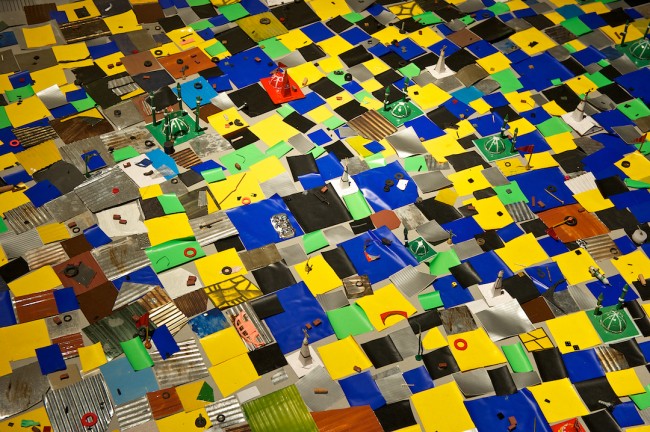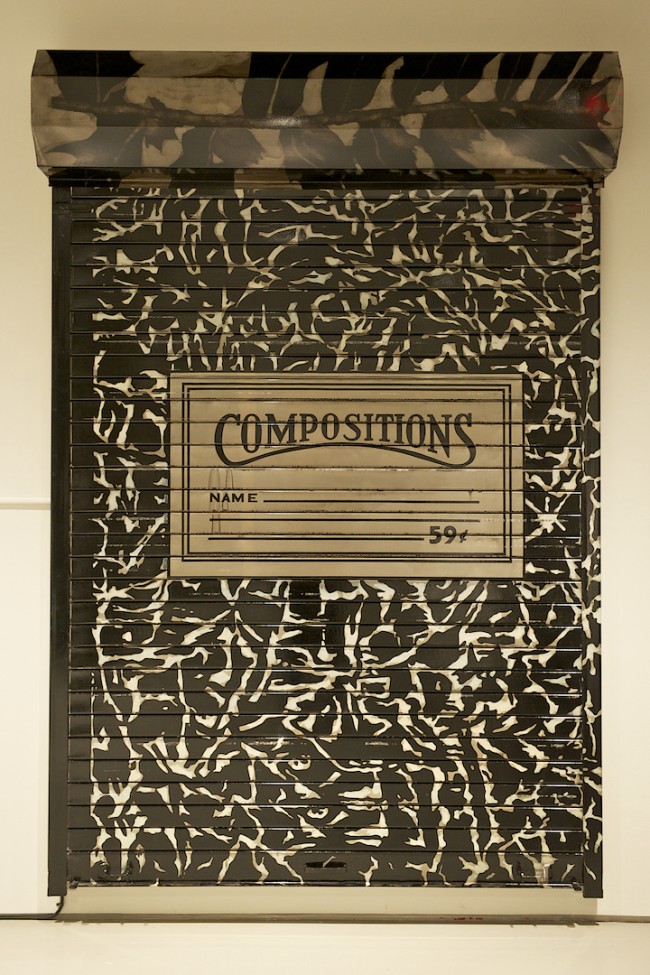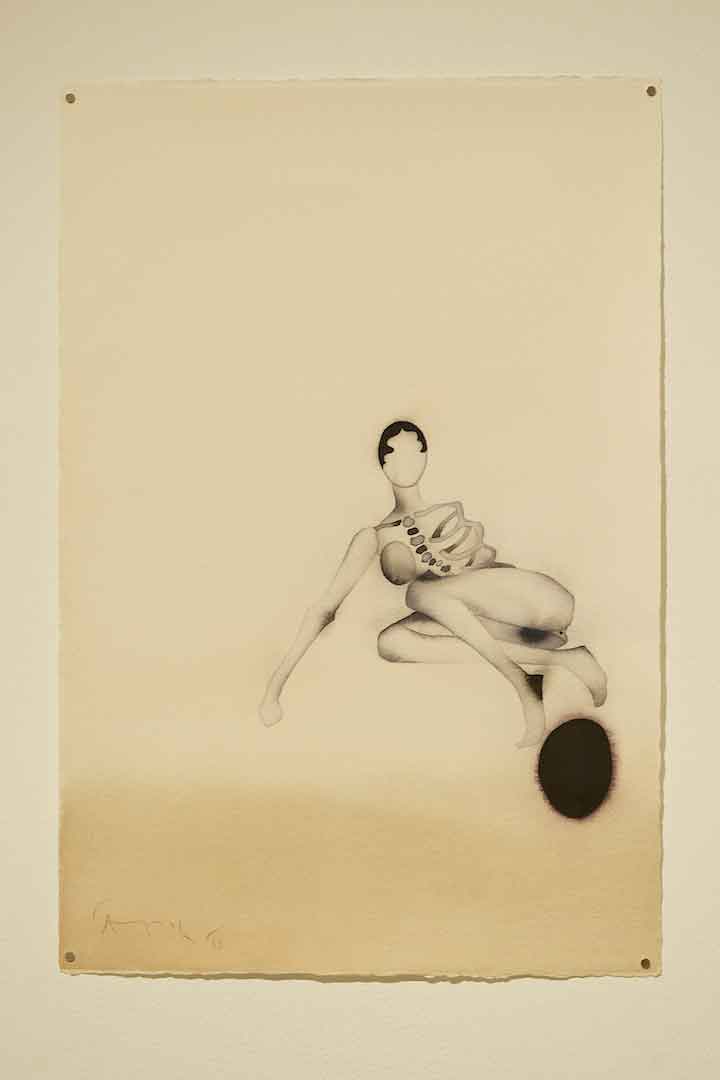Other Worlds
by Fran Watson
Hema Upadhyay and Atul Dodlya At the Contemporary Arts Center
Both artists are are from India, both have been celebrated internationally, and both exhibit imagery which contains the multiple layers of their exotic homeland and a nearly unplumbable history. My own knowledge of Indian culture is casual, at best, a fact that really didn’t hinder a very human understanding of the art forms on display at the Contemporary Arts Center in Cincinnati, Ohio through May 5. The saturated emotions poured into these messages by their creators communicate easily to those who are willing to feel them.
Hema Upadhyay’s vast sculptural interpretation of the slum of Dharavi, entitled “Modernization”, needs no explanation. A million people, crammed into one square mile of a former swamp live in tiny spaces with far from ideal conditions. Dharavi ,named the “largest slum in Asia”, is surrounded by wealthy, but overcrowded Mumbai, formerly Bombay, which, predictably, is now casting acquisition-glazed eyes on the location. The situation that faces the residents of Dharavi is far more serious than sub-standard living conditions. The specter now is being uprooted, losing neighbors and businesses.

Upadhyay’s vision of Dharavi is quite removed from the turmoil of living there. Seen from high above, the myriad particles of colorful roofs made of corrugated metal, plastic, mesh, found objects, enamel paint and car scraps carefully arranged on the gallery floor form a colorful, varied installation. Distance lends an enchantment that cannot be found in reality. Occasional high rise buildings, disturb the level sea of shacks. Here and there an indication of Christianity in the form of crosses, and Islam indicated by tiny plastic mosques and minarets suggest the spiritual side of life in a slum. Mostly, though, monotonous rooftops are curiously fit together with a locksmith’s skill, leaving no sliver of space.

Thousands of odd pieces are placed in the carefully designed Dharavi seen at the CAC. They represent a way of life, which strangely enough, is much the way its population wants it to be. This whole hodge-podge of fragments can, and have, been picked up and moved all over the world, but communities don’t work that way.
Atul Dodiya, in contrast, glories in explanation, all of which must be supplied by the viewer. He offers a plethora of possible contentions; his temporal world as opposed to a more spiritual existence, modern life compared to ancient or more meaningful customs. Every work shown is an illustration of the original yin yang philosophy.
Metal store-front shutters are suspended from a metal casing in which the motorized means of raising and lowering is housed. A button is available next to the work to raise the shutters to reveal another image beneath those painted on the metal slats. Thundering clatter accompanies the transformation contributing an ominous sound effect perfectly suited to the work. The drama unfolds in the shocking difference between the shutters and the painted canvas underneath.
Dodiya is obviously a talented painter and draftsman. The layers are equally well rendered, but in two completely different styles. The shutters are metal, and their images are the solid stuff of the present. The canvas paintings beneath belong to the realm of smoke and dreams. Underpainting emerges and recedes contributing mystery to line. Areas of fauna range from dark, heavy leaves and stems, to lacy plant skeletons. Human skeletons are painted with softened edges; reeking empathy. Designs which begin on one layer with wispy edges and indecision, emerge in another as strong and aggressive.

The motor housings themselves are meticulously joined to everything that appears below them, subtly referring so that everything in the large apparatus becomes of a piece. “Highway Yogi” begins with the metal slats painted harshly in a modern tire advertisement admonishing safety. Not until the canvas layer is revealed does the anomaly emerge. A man in a yoga position, vegetation growing from his torso, lies under the slats. Then the man reappears as a painted image painted on the motor cover making an unexpected , positive connection.

“Farewell” was the most clearly linked throughout. Its metal covering was an oversized composition notebook rendered in the artist’s signature painterly style. When raised, a poem by the Spanish poet Garcia Lorca is beautifully printed.
If I am dying
leave the balcony open.
The child is eating an orange.
(From my balcony I see him.)
The reaper is reaping the barley.
(From my balcony I hear him.)
If I am dying
leave the balcony open.
Beneath that, in furry black paint is an homage to the Motherwell painting, “Elegy to a Spanish Republic”.

A member of CAC’s staff had heard about Dodiya’s watercolors, and asked if any were available to be included. The artist replied that he had just finished some, unframed, and would toss them in his suitcase when he came. These are displayed just as they arrived, pinned to the walls unceremoniously, and somehow the better for it. For all the sophistication of Dodiya’s work, there is a primitive element hovering in them which is even more apparent in these line drawings of mannequin-like forms, enhanced by splashes of gray watercolor and occasional delicate foliage drawings.
Both Upadhyay and Dodiya present an India not often depicted. Today’s India is fraught with the contrasts and problems associated with progress. The two artists address them with compassion and personal concern.
Although photos of artwork do not always translate well to provide an adequate impression of the art itself, Fran’s article that accompanies these photos allows me to feel as though I was could have been at the exhibit. The compassion that she feels and that is part of the artists’ depictions is clearly and poignantly expressed. Thank you.
Although photos of artwork do not always translate well to provide an adequate impression of the art itself, Fran’s article that accompanies these photos allows me to feel as though I was could have been at the exhibit. The compassion that she feels and that is part of the artists’ depictions is clearly and poignantly expressed. Thank you.
I could not resist commenting. Perfectly written!
Also visit my page – best tips for makeup
I could not resist commenting. Perfectly written!
Also visit my page – best tips for makeup